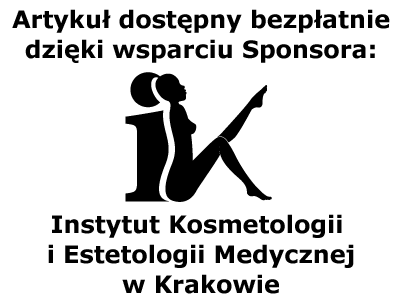Estetologia Medyczna i Kosmetologia
Home | Artykuły | Rada Naukowa | Redakcja | Dla Autorów | Prenumerata | Reklama | Kontakt | English
An occurrence analysis of ingredients declared as active in anti-hair loss products and systematic review of studies on their effectiveness
Magdalena Pyzik, Danuta Plichta, Radoslaw Spiewak
Recommended citation format: Pyzik M, Plichta D, Spiewak R: An occurrence analysis of ingredients declared as active in anti-hair loss products and systematic review of studies on their effectiveness Estetol Med Kosmetol 2020; 10: 006.en. DOI: http://dx.doi.org/10.14320/EMK.2020.006.en
Abstract
Due to the growing problem of hair loss (alopecia) in modern society, increasingly people hear the declarations of producents who describe their products as a "remedy for hair loss". From both points of view: the consument and a purely research approach, very intresting seems to be the case of scientific proves in literature of statements regarding to (actual) effectiveness of active ingredients that are present in preparations against hair loss. Aim: To analyze the occurrence of active ingredients in cosmetic preparations against hair loss and to carry out a systematic review of published studies of their effectiveness. Materials and methods: The process of preparing the present work was multistage and looked as follows: First stage of analysis involved a search in pharmacies, drugstores, cosmetics wholesalers, beauty salons and on manufacturers' websites, the preparations which were labeled (most often) by the terms "against hair loss", "hair loss treatment", "inhibits hair loss", "hair-loss prevention" and "for weak and falling hair", second stage of analysis envolved developing table specifying: name of the preparation and manufacturer, type of preparation, INCI composition declared by the manufacturer and capacity of the product with active substance content, third stage of analysis involved evaluating the ingredients according to the manufacturer's declaration that they can prevent hair loss and assigned to them functions according to the European CosIng Base, fourth stage of analysis involved analyzing scientific publications (systematic review) available in databases of the following types: Pubmed, Scopus, Web from Science, Google Scholar, Polish Medical Bibliography, according to the keywords: 'hair' AND x ('x' means the names of active substances), and performed manual review of the literature confirming the effectiveness of ingredients that, according to the manufacturer's declaration, could prevent hair loss ("active substances"). Results: In 92 analyzed hair care products which were mostly in forms of: shampoos (33.7%), followed by ampoules (18.5%), lotions (12.0%), serums (8.7%) and conditioners (7.6%). Among 448 identified substances there were 207 (46.1%) active ingredients declared by the manufacturer. Among the active substances in the analyzed products, the most common were: glycerin (glycerol – 73.9% of analysed products); yarrow extract (60.9%); polyoxyethylene 40 moles of ethylene oxide hydrogenated castor oil (41.3%); biotin (40.2%), niacinamide (nicotinamide, vitamin B3, niacin, nicotinic acid) – (30.4%); lactic acid (23.9%); panthenol (dexpanthenol, vitamin B5 – 23.9%); arginine (20.7%); menthol (19.6%); vitamin B6 (pyridoxine hydrochloride – 17.4%). From the 207 active ingredients in the analyzed hair products, only 8 had scientific confirmation of the effectiveness declared by the manufacturer. Ingredients with a confirmed effect include: zinc pyrithione, caffeine, cinnamon bark oil, oleanolic acid, extract from ginseng root, protein from placenta, extract from the root of knotweed, extract from the leaves of eastern biota. n addition, research has been found to indicate that some ingredients, e.g. niacinamide, were counterproductive. Among the analyzed studies there was also one that indicated the effectiveness of adenosine in the fight against excessive hair loss and it was not used in any of the 92 analyzed preparations. In addition, there were research found that the some active ingredients e.g. niacinamide, were counterproductive. Among the analyzed studies there was also one ingredient that indicated the effectiveness of adenosine in the fight against excessive hair loss and it was not used in any of the 92 analyzed preparations. Conclusions: In products against hair loss, the vast majority of ingredients advertized by producers as "active" has not been studied with regard to their effectiveness against hair loss. Some products "against hair loss" present on Polish market contain ingredients whose inhibitory effect on hair growth have been confirmed in research studies (niacinamide, Zingiber officinale extract, Curcuma longa extract). On the other hand, there is scientific evidence for beneficial effects of adenosine which, however, was not present in any of analyzed products.
Keywords: hair loss, alopecia, effluvium, active ingredients, cosmetic products
| Polish version |
Estetologia Medyczna i Kosmetologia online - www.estetologia.pl
Open Access, online ISSN 2084-2007; print ISSN 2084-199X, DOI: 10.14320/EstetolMedKosmetol
Wydawca udziela zgody na korzystanie z tego serwisu wyłącznie pod warunkiem akceptacji regulaminu oraz respektowania praw autorskich
Document created: 20 October 2020, last updated: 10 August 2024
© Radosław Śpiewak Instytut Dermatologii
